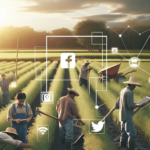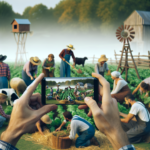Introduction to Social Media Usage in Farming
Did you know that social media platforms are proving to be essential tools for modern-day farmers? You might be surprised to learn that it’s not just tech start-ups and clothing brands benefiting from social media. From showcasing produce to connecting with the wider farming community, social media is playing a multifaceted role in the farming world.
Indeed, our growing global connectivity has empowered even those who work the land to reach out to peers, customers, and agriculture enthusiasts worldwide. But, what social media platforms are farmers using most? Why and how are these platforms beneficial to them?
In this blog post, we’ll explore the most popular social media platforms among farmers, the specific features that make these platforms appealing to the agricultural community, and how they use them effectively for both business and educational purposes. Let’s dig into the digital world of farming!
What Social Media Do Farmers Use Most?
Facebook: The Farming Hub
Farmers find Facebook an essential platform for both personal and professional use. Its versatility allows them to:
- Join farming groups and communities.
- Share updates about their farm and products.
- Engage in discussions and ask questions.
Facebook also offers features like Facebook Live, which farmers can use to stream live events, tours, or tutorials directly from their fields.
YouTube: Learning and Sharing Knowledge
YouTube is another popular platform among farmers. Here, they can:
- Watch instructional videos on farming techniques.
- Subscribe to channels that provide agricultural news and updates.
- Share their experiences and expertise through their own video content.
Many farmers follow channels like John Deere for equipment tutorials and updates.
Instagram: Visual Storytelling on the Farm
Instagram allows farmers to showcase their daily activities and products through photos and short videos. Farmers use Instagram to:
- Share the visual appeal of their produce and farm animals.
- Connect with consumers directly.
- Promote their farm-to-table experiences.
Using hashtags like #FarmLife or #AgDay helps them reach a broader audience interested in agriculture.
Twitter: Quick Updates and Networking
Twitter serves as a fast and efficient way for farmers to share:
- Real-time updates on weather conditions and crop status.
- Insights on market trends and pricing.
- Engage with industry experts and fellow farmers.
Farmers often follow organizations like the USDA for important agricultural announcements.
Pinterest: Ideas and Inspiration
Pinterest is useful for farmers looking to find and share ideas. Farmers use Pinterest for:
- Gardening tips and landscape ideas.
- DIY farm projects and improvements.
- Recipes using their farm-grown products.
This platform acts as a visual bookmarking tool for innovative farming methods and creative solutions.
LinkedIn: Professional Networking
LinkedIn isn’t just for corporate professionals. Farmers use LinkedIn to:
- Connect with other agricultural professionals.
- Join industry-specific groups for insights and networking.
- Share articles and updates on industry trends and best practices.
LinkedIn provides a platform for professional growth and staying informed on industry standards.
The Role of Social Media in Farming
In essence, social media offers farmers a way to connect, convey, and cooperate with a wider community.
Connecting with Consumers and Increasing Transparency
Farmers are increasingly using social media platforms to build connections with their consumers. They offer a glimpse into farm life, revealing where and how the products consumers purchase are produced. This transparency helps in fostering trust and loyalty among consumers. For instance, consumers who see images or videos of happy livestock or flourishing crops are more likely to believe in the farmer’s commitment to quality and ethical farming practices.
Conveying Information and Advocacy
Beyond directly marketing their products, farmers use social media to advocate for their industry. Farmers face numerous challenges, from climate change to political regulations, and the dynamic and interactive nature of platforms like Twitter allows for quick and potent dissemination of these issues. By raising awareness about the farming industry’s struggles and victories, farmers contribute to the preservation and improvement of their livelihoods.
Cooperation and Learning
Another significant role social media plays for farmers is as a medium for idea sharing and learning. Each of the different platforms facilitates this in their unique way. YouTube, for instance, provides easily accessible and demonstrative content for learning new techniques, as previously highlighted with the John Deere channel. Meanwhile, platforms like LinkedIn and Facebook provide a space for farmers to join community groups where they can ask questions, share their knowledge, or discuss relevant industry topics.
Implementing Solutions and Enhancements
Meanwhile, platforms like Pinterest offer visual inspiration for farm improvements or innovative solutions to common farming challenges. For instance, a farmer might find a creative solution to an irrigation issue or inspiration for diversifying their farm through agrotourism efforts.
It’s clear that social media plays an integral role in the modern farming industry. By utilizing these platforms, farmers can strengthen their connections to consumers, advocate for their industry, learn from others, and find innovative solutions to improve and diversify their operations.
What Social Media Do Farmers Use Most?
WhatsApp: Instant Communication
Farmers are increasingly adopting WhatsApp for its instant messaging capabilities. This app enables quick communication with:
- Suppliers and vendors for timely delivery of goods and services.
- Other farmers for sharing tips and real-time problem-solving.
- Consumers for sales queries and customer support.
WhatsApp groups can also serve as a platform for local farming communities to exchange weather updates, market prices, and urgent alerts.
TikTok: Engaging a Younger Audience
TikTok has gained traction among younger farmers looking to share their farming techniques and experiences in short, engaging videos. This app is useful for:
- Showcasing innovative farming methods.
- Responding to farming challenges with creative solutions.
- Engaging a younger audience, potentially attracting the next generation of farmers.
Many farmers use trending challenges and hashtags to reach a broader audience and foster online agricultural communities.
Reddit: Crowd-Sourced Knowledge
Reddit offers a unique platform for farmers to crowd-source solutions and participate in varied discussions. Farmers participate in subreddits like r/farming to:
- Ask and answer specific farming questions.
- Share experiences and get advice on various techniques.
- Discuss topics ranging from equipment recommendations to organic farming practices.
The community-driven nature of Reddit makes it a reliable source of peer-verified information.
Telegram: Secure and Organized Communication
Telegram provides a secure and feature-rich alternative for farmer communication. Farmers use Telegram for:
- Forming private groups with advanced security features for sensitive information.
- Accessing channels dedicated to agricultural news.
- Using integrated tools like bots for market price alerts and weather updates.
The app’s large file-sharing capability also benefits farmers wanting to share detailed documents or high-resolution images of crop conditions.
Snapchat: Behind-the-Scenes Peeks
Snapchat is increasingly used by farmers to offer behind-the-scenes glimpses of farm life through quick, ephemeral snapshots and videos. Farmers leverage Snapchat to:
- Share day-to-day activities on the farm.
- Engage younger demographics through entertaining and informative content.
- Use geofilters to promote their farm location and events.
With Snapchat’s informal and playful format, farmers can build a more personal connection with their audience.
Discord: Community Building and Real-Time Collaboration
Discord is another emerging platform where farmers build community through real-time collaboration. Farmers use Discord for:
- Joining agricultural servers for diverse topic discussions.
- Utilizing voice channels for live communication and instant feedback.
- Collaborating on shared farming projects and initiatives.
Discord’s multifaceted communication tools, including voice, text, and video, make it a versatile option for building a tightly-knit farming community.
What are Social Media Post Ideas for Farmers?
Share Tips and Tutorials
Farmers can use their social media platforms to provide valuable tips and tutorials. This not only adds value to their followers but also positions them as knowledgeable in their field.
- Step-by-step guides on planting and harvesting specific crops.
- Tips on organic farming and sustainable practices.
- DIY instructions for building farm equipment or structures.
Creating a quick video on YouTube or Instagram can make these tutorials more engaging.
Host Q&A Sessions
Interactive sessions, like Q&As, can foster a deeper connection with an audience. Farmers can utilize platforms like Facebook Live, Instagram Stories, or even Twitter for these sessions.
- Answer common questions about farm operations.
- Discuss agricultural techniques and innovations.
- Provide advice for small-scale farmers or home gardeners.
Announce the Q&A ahead of time and encourage followers to submit questions in advance.
Farm-to-Table Recipes
Sharing recipes that use farm-produced ingredients can attract food enthusiasts and home cooks. This idea works particularly well on Pinterest and Instagram.
- Seasonal recipes that highlight fresh produce.
- Farm-to-table meal prepping ideas.
- Preservation tips for produce (pickling, canning, etc.).
High-quality photos and step-by-step instructions make these posts more appealing.
Behind-the-Scenes Content
People love to see what goes on behind the scenes. Providing a glimpse into everyday farm life can make the farm feel more relatable and authentic.
- Daily routines and chores.
- Animal care and feeding practices.
- Footage of planting and harvesting seasons.
Platforms like Snapchat and TikTok are excellent for quick, behind-the-scenes clips.
Share Success Stories
Sharing stories of success can inspire others and showcase the farmer’s achievements.
- Personal milestones like winning awards or achieving certifications.
- Stories of overcoming challenges like weather adversities.
- Successful sales stories or collaborations with local businesses.
A well-crafted post on LinkedIn or a detailed Instagram caption can effectively share these stories.
Promote Events and Workshops
Events and workshops can generate interest and bring the community together. Use platforms like Facebook Events or Instagram Stories to promote these occasions.
- Farm tours and open houses.
- Workshops on topics like sustainable farming or organic gardening.
- Local farmers’ markets and fairs where the farm’s products will be sold.
Creating event pages or sharing countdowns can build anticipation and engagement.
Collaborate with Influencers
Collaborating with influencers in agriculture or related fields can expand a farmer’s reach.
- Guest blog posts or video collaborations with agricultural influencers.
- Joint giveaways to attract a broader audience.
- Sharing testimonials from well-known food or health bloggers.
Platforms like Instagram and YouTube are especially conducive to collaborations.
Highlight Community Involvement
Showing active participation in the local community builds goodwill and trust.
- Posts about donations or sponsorships to local schools or events.
- Participation in community projects or volunteer work.
- Support for local businesses and fellow farmers.
Facebook and Twitter are good platforms to amplify these efforts.
Leveraging these diverse social media post ideas can help farmers engage their audience, share their expertise, and foster a deeper connection with their community. For additional social media strategies, visit the Agriculture.com social media tips for farmers page. This resource offers more excellent tips tailored to the agricultural industry.
Summing Up Farmers’ Use of Social Media
Through various social media platforms, farmers discover a wide array of prospects for their operations. Facebook brings together a community of farmers, opening a gateway of communication, learning, and support. YouTube paves the way for continuous learning and sharing, with Instagram adding the element of visual appeal to a farmer’s experiences.
Twitter enables real-time news and updates, and Pinterest stimulates creativity and innovation, while LinkedIn maintains the professionalism in the agriculture sector. Lastly, apps like WhatsApp, TikTok, and Reddit elevate the entire spectrum by offering instant communication, engaging younger audiences, and crowdsourcing knowledge respectively.
Frequently Asked Questions – FAQs
Which social media platform is optimal for farmers looking to connect with other professionals?
LinkedIn serves as the go-to platform for professional connections, including those in the agricultural sector.
How do farmers use YouTube?
Farmers use YouTube for watching and sharing instructional videos, following agricultural news and updates, and sharing their expertise.
How can farmers use social media to engage with consumers?
Farmers can use social media to share updates about their farm and products, engage in discussions, answer questions, and showcase the visual appeal of their produce and farm animals.
What is a significant benefit of using Twitter for farmers?
Twitter allows for fast and efficient sharing of real-time updates on weather conditions, crop status, insights on market trends and pricing, and industry-related discussions.






